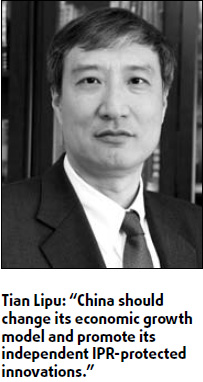IPR Special: IPR Strategy Key to Nation's Sustainable Growth
Since China began to implement its National Intellectual Property Strategy on June 5 last year, the nation has achieved remarkable progress in this field.
Intellectual property rights (IPR) protection is a serious concern for both the central and local governments, as well as for foreign businesses operating in China.
In June 2008, Chinese President Hu Jintao told a political bureau meeting that China would promote independent innovations through strengthening developments in science and education, human resources and intellectual property.
Premier Wen Jiabao, wrote an article for the Qiushi magazine, the primary theoretical journal of the Central Committee of the Communist Party of China, saying that the IPR strategy is important for China's development as a nation's technological and economic competitiveness depends largely on the competitiveness of its own intellectual property.

The State leaders' statements are especially true in the context of an era of knowledge-based economies.
IPR protection involves a legal system that aims to promote the market value of inventions and innovations through offering legal protection for the IPR owners.
Some Western countries, for example, the United Kingdom, began to implement their IPR system 300 years ago. The system has played an important role in the miraculous economic progress of the West in past centuries.
In contrast, the lack of such a mechanism discourages inventions and innovations and is one of the reasons why the Chinese economy has lagged behind Western countries for a long time.
During the past three decades of reform and opening up, China has achieved remarkable developments in the social and economic fields. This is also closely related to the steady progress in the implementation of its IPR system.
It's hard to imagine how China could attract substantial sums of foreign investment and become a member of the World Trade Organization without committing to effectively implementing an IPR system.
More importantly, the improvements in IPR protection have also played a big role in establishing a market economy, strengthening independent innovations and raising the competitiveness of the nation and the core competence of many domestic businesses.
Challenges
Despite all these achievements, we are fully aware of the challenges facing us in the arena of IPR protection.
First, without the IPRs to many core technologies, China's manufacturing industry is focusing on the low-end of the value chain. The nation's rapid economic growth has to depend too much on labor-intensive sectors and industries with heavy resource and energy consumption. These sectors are typically vulnerable when global competition intensifies and a worldwide economic crisis takes place.
Secondly, relying on their strong innovative capacities, the developed countries and the multinational companies from these countries are always the winners when it comes to global competition. These companies tend to use their exclusive IPRs and technologies to maintain their monopoly positions in their respective markets.
In these circumstances, China should change its economic growth model and promote its own independent innovations. As part of this process, the role of IPR protection should be enhanced.
The Chinese government has realized the importance of implementing an IPR strategy.
After three years of preparation and as the result of the close cooperation among more than 30 ministries and institutions under the central government, the National Intellectual Property Strategy was passed by the State Council on April 9, 2008 and took effect from June 5 of the same year.
This is the nation's guideline document for the IPR system implementation. For the first time, IPR strategy has become a part of the country's medium and long-term development plan.
After the IPR strategy was released, the State Council immediately approved the establishment of a joint conference mechanism to take charge of the implementation and promotion of the IPR strategy.
The joint conference is headed by the State Intellectual Property Office and supported by another 28 ministries and institutions. The first plenary meeting of the joint conference was held on November 21, 2008, presided over by Vice-Premier Wang Qishan.
A crucial year
This year is a crucial period for the implementation of the strategy. The joint conference has now released the 2009 Plan for Promoting the Implementation of the National Intellectual Property Strategy.
The plan includes measures to create a better legal environment for IPR protection, improve government services and enhance the popularization of the strategy.
The plan has also proposed measures to deal with the current global economic downturn. To encourage enterprises to strengthen their global competitiveness through their independent innovations, the plan proposes that the government, at various levels, should offer more policy and financial supports to help enterprises strengthen investment in innovation.
The plan said directing more investment into innovation is not only a part of the nation's economic stimulus initiative but can also promote the country's industrial restructuring.
The IPR strategy has also seen active responses from the local governments, industrial associations and enterprises.
Special organizations have been established in many provinces, autonomous regions and municipalities to oversee the drafting and implementation of their own IPR strategies. To date, more than 10 provinces and municipalities have released their own implementation plans.
With the help of their corresponding industrial associations, the railway, traditional Chinese medicine and steel making industries are the first sectors to benefit from the strategy. They are already seeing enhanced investment in research, development and brand building.
Tian Lipu is the commissioner of the State Intellectual Property Office
(China Daily 06/15/2009 page9)
2013-07-17 Print
Print